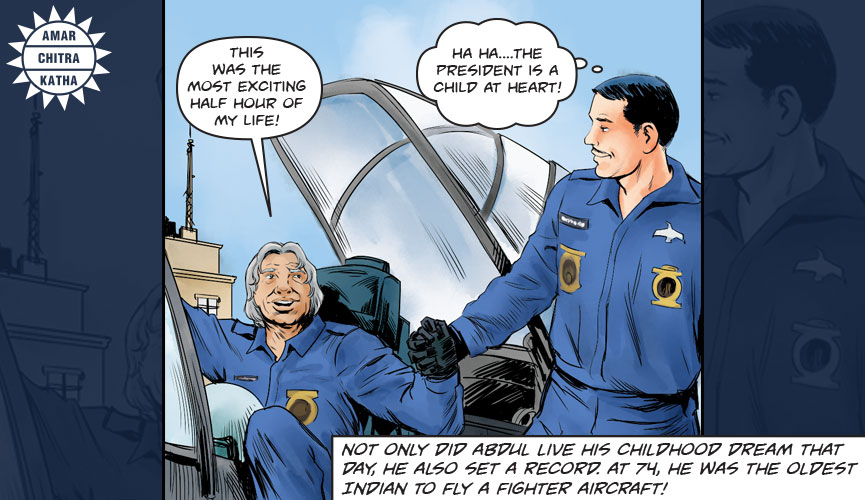APJ Abdul Kalam (1931 – 2015)
- July 2, 2021


APJ Abdul Kalam (1931 – 2015)
- July 2, 2021
By Srinidhi Murthy
Avur Pakir Jainulabdeen Abdul Kalam was loved and respected as a scientist, a teacher, a visionary, and then as the 11th President of our country. No one would have thought that this little boy from Rameswaram would one day be honored with the Bharat Ratna, India’s most prestigious award, and will always be remembered for his vision for India.

Born on 15th October 1931, Abdul was the youngest child of Jainulabdeen and Ashiamma. His father was the Imam at the local Mosque of Rameswaram and led worshippers during prayers. Many people considered him to be a healer. They brought water to him and he dipped his fingers into it while chanting prayers. This water was then used for healing people. His father often explained to young Abdul the power of faith and prayer. This advice probably stayed with him throughout his lifetime.
To receive more such stories in your Inbox & WhatsApp, Please share your Email and Mobile number.

Young Abdul Kalam got admission into the Madras Institute of Technology. His parents did not know how to meet the cost of his higher education. His elder sister, Zohra gave her gold bangles to make ends meet even though she had little money for her own household needs. Abdul was touched by this selfless gesture. He studied hard to get a scholarship to redeem the piece of jewellery that she had given up.
After completing his education, Dr Kalam got a job at the Indian National Committee for Space Research as a Rocket Engineer. There he was introduced to Dr Vikram Sarabhai, one of the pioneers of India’s Space Programme. Kalam was assigned to work with Group Captain VS Narayanan to Develop a Rato, which is a Rocket-assisted Take-off system, in eighteen months. The team successfully completed the project in just sixteen months and conducted sixty-four Rato Static tests. This saved the country roughly INR four crores in foreign exchange.

While working at ISRO, Dr. Kalam was saved from the explosion of payloads, the dangerous mix of pure sodium and thermite, by his colleague Sudhakar. This selfless act of Sudhakar inspired Dr Kalam to work even harder and make his life more meaningful and useful to others. He again faced danger in 2001, when the helicopter in which he was travelling crashed in Bokaro. Though nobody was injured, this second clash with death made Dr Kalam turn to a career in teaching and unfold his vision for India.
In June 2002, Dr Abdul Kalam got a call from the then Prime Minister, Atal Bihari Vajpayee. The PM expressed his wish to nominate him for the post of President. Vajpayee gave Kalam two hours to make up his mind and give his answer. After consulting with his family and friends, he accepted the offer and was sworn in as the 11th President of India on 25th July 2002.
The swearing-in ceremony of Dr. APJ Abdul Kalam was attended by the head of Ramanathaswamy Temple, the priest of Rameshwaram Church and the imam of Rameshwaram Mosque, apart from his family and colleagues.
When Dr Kalam started his tenure as the president of India, he initiated e-governance in Rashtrapati Bhawan and changed the way of work being done in his office.

While visiting the Air force Base in Pune in June 2006, President Kalam expressed his dream of becoming a fighter pilot. Immediately, the pilots around him encouraged him to fly with them as the co-pilot. The President flew in the fighter aircraft for half an hour. With this feat, he not only achieved his childhood dream but also became the oldest Indian to fly a fighter aircraft at the age of seventy -four.
This visionary passed away on 27 July 2015 while delivering a lecture to students at the Indian Institute of Management, Shillong.
Read the story of Abdul Kalam in our title APJ Abdul Kalam, now available on the ACK Comics App, Kindle, Amazon, Flipkart, and other major e-tailers.
To receive more such stories in your Inbox & WhatsApp, Please share your Email and Mobile number.

Comic of The Month
Dr Kotnis in China
In 1938, twenty-eight-year-old Dr Dwarkanath Kotnis was part of a medical mission that India sent to aid China in its war with Japan. Dr Kotnis was committed to saving lives, even in the precarious war-time situation. He remained behind to continue his work in China after the rest of his group returned. He was, and remains, a selfless and fearless hero to the people of China and India alike.